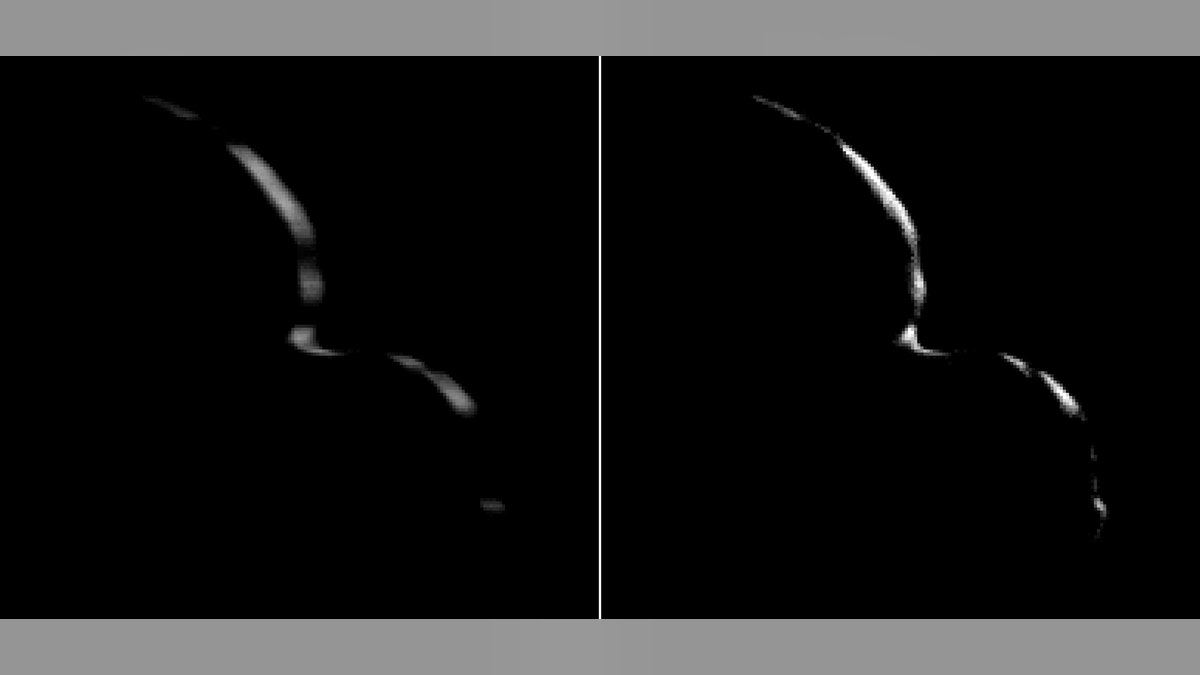
New Horizons took this image of Ultima Thule on Jan. 1, 2019, when the NASA spacecraft was 5,494 miles (8,862 kilometers) beyond it. The image to the left is an "average" of ten images taken by the Long Range Reconnaissance Imager; the crescent is blurred in the raw frames because a relatively long exposure time was used during this rapid scan to boost the camera’s signal level. Mission scientists have been able to process the image, removing the motion blur to produce a sharper, brighter view of Ultima Thule's thin crescent. (Credit: NASA/Johns Hopkins Applied Physics Laboratory/Southwest Research Institute/National Optical Astronomy Observatory)
Sorry, Ultima Thule: no corn cob pipe or button nose for you.
After initially thinking it looked like a reddish snowman, because of its two components, the icy object known as Ultima Thule has "melted" into "giant pancake" and "a dented walnut," NASA said in a statement on Saturday.
"The first close-up images of Ultima Thule – with its two distinct and, apparently, spherical segments – had observers calling it a 'snowman,'" the government space agency said. "However, more analysis of approach images and these new departure images have changed that view, in part by revealing an outline of the portion of the KBO that was not illuminated by the Sun, but could be 'traced out' as it blocked the view to background stars."
NASA ANNOUNCES LATEST DISCOVERIES FROM ULTIMA THULE FLYBY
Fourteen newly released images show that the object is significantly flatter than previously thought, mission Principal Investigator Alan Stern, of Southwest Research Institute said.
"We had an impression of Ultima Thule based on the limited number of images returned in the days around the flyby, but seeing more data has significantly changed our view," Stern said in the statement. "It would be closer to reality to say Ultima Thule's shape is flatter, like a pancake. But more importantly, the new images are creating scientific puzzles about how such an object could even be formed. We've never seen something like this orbiting the Sun."

Scientists' understanding of Ultima Thule has changed as they review additional data. As more data were analyzed, including several highly evocative crescent images taken nearly 10 minutes after closest approach, a "new view" of the object's shape emerged. Ultima more closely resembles a "pancake," and Thule a "dented walnut." (Credit: NASA/Johns Hopkins University Applied Physics Laboratory/Southwest Research Institute)
In early January, the $720 million New Horizons mission captured pictures of Ultima Thule. Ultima Thule is deep within the so-called Kuiper Belt, or Twilight Zone, well beyond the orbit of Neptune.
Scientists have also said recently that they have not yet found any evidence of an atmosphere on UItima Thule. Initial data analysis has also uncovered no evidence of rings or satellites larger than 1 mile in diameter orbiting Ultima Thule.
In 2015, New Horizons successfully flew past Pluto, which revealed that the dwarf planet is surprisingly diverse, Space.com reported. Ultima Thule is approximately 4.1 billion miles from Earth and about 1 billion miles past Pluto, making it the most distant celestial object ever explored.
NASA'S HUBBLE TELESCOPE UNCOVERS NEPTUNE'S NEW 'MYSTERIOUS DARK VORTEX,' URANUS' GIANT WHITE CAP
Despite its lack of resemblance to Frosty or any other snowman for that matter, Ultima Thule continues to amaze scientists.
"This really is an incredible image sequence, taken by a spacecraft exploring a small world four billion miles away from Earth," Stern added. "Nothing quite like this has ever been captured in imagery."
CLICK HERE TO GET THE FOX NEWS APP
Though it will take approximately 20 months for New Horizons to get all of its pictures, measurements and other scientific data back home to Earth, the newly released images are sure to "motivate new theories of planetesimal formation in the early solar system," Hal Weaver, New Horizons project scientist from the Johns Hopkins Applied Physics Laboratory, said.
Fox News' James Rogers contributed to this report.








































